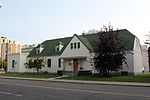Ukrainian Catholic Eparchy of Edmonton
AC with 0 elementsCanadian Roman Catholic diocese stubsEastern Catholic diocese stubsEastern Catholic dioceses in CanadaReligious sees in Edmonton ... and 4 more
Ukrainian Catholic Church in CanadaUkrainian Catholic Metropolia of WinnipegUkrainian Greek Catholic Church stubsUkrainian Greek Catholic eparchies

The Eparchy of Edmonton is a Ukrainian Greek Catholic Church ecclesiastical territory or eparchy of the Catholic Church that governs parishes in the Canadian province of Alberta. It uses the Byzantine Rite liturgy in the Ukrainian language and English language. The eparchy's cathedral is St. Josaphat's Cathedral in the episcopal see of Edmonton, Alberta.
Excerpt from the Wikipedia article Ukrainian Catholic Eparchy of Edmonton (License: CC BY-SA 3.0, Authors, Images).Ukrainian Catholic Eparchy of Edmonton
96 Avenue NW, Edmonton Central Core
Geographical coordinates (GPS) Address Nearby Places Show on map
Geographical coordinates (GPS)
| Latitude | Longitude |
|---|---|
| N 53.533333333333 ° | E -113.5 ° |
Address
96 Avenue NW 10406
T5K 2E9 Edmonton, Central Core
Alberta, Canada
Open on Google Maps







